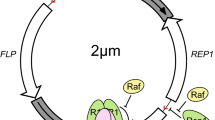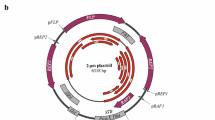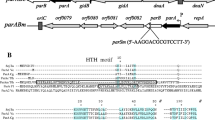Summary
The yeast 2 μm circle encodes four major transcribed open reading frames, A, B, C and D. Products of ORF's A, B and C, together with the inverted repeats and the other cis-acting loci ORI and STB, have been shown to be involved in plasmid maintenance. However, the function of ORF D has remained unclear. We have therefore carried out studies on 2 μm derivatives with both insertional and frameshift mutations in D. Our results indicate that there is a protein product encoded by ORF D, which is involved in plasmid maintenance. When the copy number of the C gene was reduced to one, by chromosomal integration, we observed striking differences in the efficiency of partitioning of D + and D − plasmid derivatives. Absence of D function could be compensated by an increase in dosage of the C gene, indicating that the D product may act to regulate C expression. Since the C product has been implicated in copy number control as well as partitioning, our data suggest that the D product may also be involved in both of these processes.
Similar content being viewed by others
References
Beggs JD (1978) Transformation of yeast by a replicating hybrid plasmid. Nature 275: 104–109
Beggs JD, Guerineau M, Atkins JF (1976) A map of the restriction targets in yeast 2-micron plasmid DNA cloned in bacteriophage Lambda. Mol Gen Genet 148: 281–294
Birnboim AC, Doly J (1979) A rapid alkaline extraction procedure for screening recombinant plasmid DNA. Nucleic Acids Res 76: 1513–1523
Broach JR, Hicks JB (1980) Replication and recombination functions associated with the yeast plasmid 2 μ circle. Cell 21: 501–508
Cashmore AM (1984) Factors involved in the maintenance of plasmids in yeast. PhD Thesis, CNAA
Cashmore AM, Albury MS, Hadfield C, Meacock PA (1986) Genetic analysis of partitioning functions encoded by the 2 μm circle of Saccharomyces cerevisiae. Mol Gen Genet 203: 154–162
Dobson MJ, Futcher AB, Cox BS (1980) Loss of 2 μm DNA from S. cerevisiae transformed with the chimaeric plasmid pJDB219. Curr Genet 2: 201–205
Futcher AB (1986) Copy number amplification of the 2 μm circle plasmid of Saccharomyces cerevisiae. J Theor Biol 119: 197–204
Futcher AB, Cox BS (1984) Copy number and the stability of 2 μm circle-based artificial plasmids of Saccharomyces cerevisiae. J Bacteriol 157: 283–290
Hartley JL, Donelson JE (1980) Nucleotide sequence of the yeast plasmid. Nature 286: 860–864
Ito H, Fukuda Y, Murata K, Kimura A (1983) Transformation of intact yeast cells treated with alkali cations. J Bacteriol 153: 163–168
Jayaram M, Li Y-Y, Broach JR (1983) The yeast plasmid 2 μm circle encodes components required for its high copy propagation. Cell 34: 95–104
Kikuchi Y (1983) Yeast plasmid requires a cis-acting locus and two plasmid proteins for its stable maintenance. Cell 35: 487–493
Maniatis T, Fritsch EF, Sambrook J (1982) Molecular cloning. A laboratory manual Cold Spring Harbor Laboratory, Cold Spring Harbor, New York
McLeod M, Volkert F, Broach JR (1984) Components of the site-specific recombination system encoded by the yeast plasmid 2-micron circle. Cold Spring Harbor Symp Quant Biol 49: 779–787
Murray AW, Szostak JW (1983) Pedigree analysis of plasmid segregation in yeast. Cell 34: 961–970
Murray JAH (1987) Microreview — Bending the rules: the 2 μ plasmid of yeast. Mol Microbiol 1: 1–4
Murray JAH, Cesareni G (1986) Functional analysis of the yeast plasmid partition locus STB. EMBO J 5: 3391–3399
Reynolds AE, Murray AW, Szostak JW (1987) Roles of the 2 μm gene products in stable maintenance of the 2 μm plasmid of Saccharomyces cerevisiae. Mol Cell Biol 7: 3566–3573
Sutton A, Broach JR (1985) Signals for transcription initiation and termination in the Saccharomyces cerevisiae plasmid 2 μm circle. Mol Cell Biol 5: 2770–2780
Veit BE, Fangman WL (1985) Chromatin organisation of the Saccharomyces cerevisiae 2 μm plasmid depends on plasmid encoded products. Mol Cell Biol 5: 2190–2196
Vieira J, Messing J (1982) The pUC plasmids, an M13mp7-derived system for insertion mutagenesis and sequencing with synthetic universal primers. Gene 19: 259–268
Volkert FC, Broach JR (1986) Site-specific recombination promotes plasmid amplification in yeast. Cell 46: 541–550
Wu L-CC, Fisher PA, Broach JR (1987) A yeast plasmid partitioning protein is a karyoskeletal component. J Biol Chem 262: 883–891
Author information
Authors and Affiliations
Additional information
Communicated by C.P. Hollenberg
Rights and permissions
About this article
Cite this article
Cashmore, A.M., Albury, M.S., Hadfield, C. et al. The 2 μm D region plays a role in yeast plasmid maintenance. Mol Gen Genet 212, 426–431 (1988). https://doi.org/10.1007/BF00330846
Received:
Issue Date:
DOI: https://doi.org/10.1007/BF00330846




